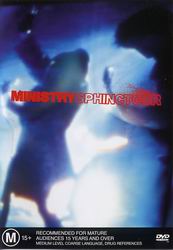Ministry-Sphinctour (1996) (NTSC) |
|
Ministry-Sphinctour (1996) (NTSC) |
|


|
| BUY IT |
| General | Extras | ||
| Category | Music |
Menu Audio Gallery-Passes |
|
| Rating |

|
||
| Year Of Production | 1996 | ||
| Running Time | 87:39 | ||
| RSDL / Flipper | No/No | Cast & Crew | |
| Start Up | Menu | ||
| Region Coding | 4 | Directed By |
Jeffery Kinart Doug Freel |
|
Studio
Distributor |
 Warner Vision |
Starring |
Hypo Luxa Hermes Pan Louis Svitek Duane Buford Reynolds Washman Zlatko Hukic |
| Case | Click | ||
| RPI | $34.95 | Music | Ministry |
| Video (NTSC) | Audio | ||
| Pan & Scan/Full Frame | Full Frame |
English Dolby Digital 5.1 (448Kb/s) English Dolby Digital 2.0 (448Kb/s) |
|
| Widescreen Aspect Ratio | None | ||
| 16x9 Enhancement | No | ||
| Video Format | 480i (NTSC) | ||
| Original Aspect Ratio | 1.33:1 | Miscellaneous | |
| Jacket Pictures | No | ||
| Subtitles | None | Smoking | Yes |
| Annoying Product Placement | No | ||
| Action In or After Credits | Yes | ||
After devouring Psalm 69 like raving mad piranha in 1991, Ministry fans had to wait five years for the band's next release, Filth Pig. This album signalled a new direction for the group, featuring a slower, more introverted guitar sound, and only traces of the electro-industrial texturing they had mastered on offerings like The Mind is a Terrible Thing to Taste. Still, the relentless rhythm section, festering guitar riffs and throat-cancer vocals remained the same as always. Bordering on doom metal, the end result was a mixture of classic new songs such as 'Filth Pig' and tedious, overproduced dirges like 'The Fall'.
I bought the album but rarely played it, preferring the frenetic onslaught of Psalm 69 and In The Land of Rape and Honey. By this time, comparable acts such as Fear Factory, Nine Inch Nails and Marilyn Manson had gained wider acceptance. As a consequence, the withdrawal of Ministry had little impact on the genre they pioneered 17 years ago. Most tragically, there have been no new albums from the band's side-project Revolting Cocks since 1993's satirical masterpiece Linger Ficken Good.
Ostensibly a live recording of the Filth Pig world tour of '96, Sphinctour offers a novel approach to presenting concert footage. The images, captured on one Hi-8 camera by Doug Freel and Jeffery Kinart (who both edited, produced and directed) are a composite of various performances. Although the tour had 60 engagements, only a fraction (13?) seem to appear in the final cut. Furthermore, each of the 13 songs on the play list is sourced from a different venue. The constant changes in attire, stage dressing, and crowd orientation suits Ministry's screwball eccentricity. In their legendary 1990 live video Just in Case You Didn't Feel Like Showing Up, a dirty big cyclone fence separated the musicians from the mosh pit, and Dead Kennedys frontman Jello Biafra made a surreal cameo appearance. At least here we get to see the late Timothy Leary backstage, wearing a huge red sweater.
Now seven years old, Sphinctour lacks the quirkiness of Just in Case. The band line-up and mix of songs was better on the earlier concert than on this one, although that obviously reflects my personal tastes. As for the multi-concert approach, it does let you experience several shows at once, but the costumes and antics of frontman Al Jourgensen are not enough to justify this gimmick. A better alternative would have provided one performance filmed properly with cameras on cranes, dolly tracks, and the whole shebang, and another showing the composite version, with its bootleg aesthetic and in-your-face vigour. Mindful that every concert on this tour was being videotaped, the band may not have given performances worth watching over and over again, as they did with Just in Case You Didn't Feel Like Showing Up. These are, however, subjective concerns that should not be taken too earnestly; the concept may work beautifully for you.
With The Tapes of Wrath and Sphinctour now on DVD, the only omissions from the Ministry video coffers are Just in Case You Didn't Feel Like Showing Up and The Revolting Cocks Live. If there was ever an official release of the Psalm 69 tour on video, I've never seen it around. Amazon Dot Com certainly ain't selling it, so I think it's safe to say it don't exist.
Sphinctour Band Line Up
Al 'Grandpa' Jourgensen - Vocals, guitar
Paul Barker - Bass guitar
Louis Svitek - Lead guitar
Reynolds Washman - Drums
Duane Buford - Keyboards and samples
Zlatko Hukic - Guitar
| 1. Psalm 69 2. Crumbs 3. Reload 4. Filth Pig 5. So What? 6. Just One Fix 7. N.W.O. | 8. Hero 9. Thieves 10. Scarecrow 11. Lava 12. The Fall 13. Stigmata |
The composition of shots varies from 1.85:1 to 1.33:1. Those of you with widescreen TVs will occasionally see heads cut in half if the image is zoomed to fill your screen. My guess is that the two camera operators were used to framing shots differently, one for potential matting and the other for home video. A careful dissection of the concert may provide the answer, assuming Jeffery Kinart and Doug Freel did not swap camera chores during a performance! For this review, Sphinctour was played in all its full-frame glory.
The hand-held Hi-8 recording equipment has provided less-than-ideal source materials. Thus, while sharpness is crisp and detail is reasonably good, shadow detail is lacking. There is no edge enhancement per se, but the image is nonetheless harsh and brittle. Blacks are nice and solid whenever the patina of video noise vanishes. When shown at normal speed, the picture quality appears to be glossy, but the real nature of the transfer becomes apparent in slow motion.
Like most night-time concerts, the isolated splashes of colour struggle to make a lasting impression due to the dim lighting, drab stage decoration and omnipresent smoke haze. Saturation and colour bleed are as good as the video origins allow for, and skin tones are accurate. Bright areas tend to clump into dollops of colour that obliterate detail.
Being video, there are no film artefacts. Thankfully, there are no video tape-related defects such as dropouts and noise lines, either. With so much coverage on hand, one imagines that any problematic segments would have been deleted with one virtual jog of the editing software. There are, occasionally, some vulgar displays of aliasing, fr'instance at 9:35 on Paul Barker's guitar strings and at 28:14 on the drum riser. Gauze on speaker amps also shimmers horribly. The compression seems to have handled the video noise well. Freeze frames show an even spread of fine pixels, together with flashes of cross-colour banding. These rough patches are symptomatic of the digital videography and not the MPEG-2 compression.
Yes, there are issues. But...the first time I watched Sphinctour I drank five stubbies of Hahn Premium beer. In this more relaxed state of mind, I assure you that the picture quality was perfectly serviceable.
There are no subtitles for lyrics.
| Sharpness | |
| Shadow Detail | |
| Colour | |
| Grain/Pixelization | |
| Film-To-Video Artefacts | |
| Film Artefacts | |
| Overall |
Al Jorgensen's vocals are as clear as they could be. Although positioned at the centre of the sound stage, all speakers give voice to Al's warblings. Synchronization chopped and changed because of the insertion of different performances during any given song, but the overall effect is seamless, and certainly no worse than any other live concert I've seen on video. Distortion is not a problem.
Okay then, what about the music? Does it shred? Yes, I am happy to report that it does indeed shred. The abrasive guitars and pounding rhythm section practically surges out of the speakers. Because of the front-heavy original recording, the guitars and drums only enjoy a modicum of separation. What you do get is the glorious 'wall of sound' that Ministry is famous for. The lead guitar and snare drum are centred squarely in the middle, although Louis Svitek's lead breaks tend to issue from the centre speaker, whereas the crack of the snare comes from the space between the main front speakers, i.e. the TV screen. Miscellaneous guitar chords may be heard stage left or right ('Crumbs'), but these are rare. There are also artificial pans between the front speakers, for example during the opening bars of 'Just One Fix'. Duane Buford and his synthesizer make themselves heard at the appointed moments.
At the lower end of the frequency spectrum, the bass drum pulses out a pleasingly deep sound indigenous to the subwoofer. Paul Barker's bass doodling, which registers as a vague but omnipresent rumble, is all but lost in the mix, as would be the case in a live situation. The bass kicks do actually disappear during 'Just One Fix' and 'N.W.O', which just happen to be two of Ministry's biggest numbers, so I was not thrilled about that. It may have something to do with the addition of Al Jourgensen on lead guitar for these two songs; usually he just sings. The bass drum re-emerges for the very next song 'Hero'. The outro of 'The Fall' dumps out waves of bass which may rattle windows at high volumes.
The surrounds are active in the sense that they draw the essentially stereo mix around the viewer like a curtain. Everything on the track - vocals, drums, guitars, keyboards, samples - are embedded in the rear channels, albeit at lower volumes. Every now and then samples and soundbytes zing through the room, such as the whirring drill in 'Thieves' (I have always loved that drill), and the '69' voice sample in 'Psalm 69'.
Switching to the Dolby Digital 2.0 soundtrack results in an immediate drop in decibels, soundfield presence, fidelity, dynamic range, and all-round gutsiness. Twisting the volume up to compensate produces a fair facsimile of the stronger 5.1 mix: the bass kicks are still there, and the processed guitars scrape away at the indignities of the world. It is handy to have this native 2.0 track for Pro-Logic sound systems.
Sphinctour has also been released on VHS, CD and, most interestingly, DVD-A.
| Dialogue | |
| Audio Sync | |
| Clicks/Pops/Dropouts | |
| Surround Channel Use | |
| Subwoofer | |
| Overall |
NOTE: To view non-R4 releases, your equipment needs to be multi-zone compatible and usually also NTSC compatible.
Sphinctour is another solid release for the Ministry faithful. In my opinion, anything this band does is interesting. I recall that Nine Inch Nails have also applied the multi-concert approach to their latest live package, so the technique used here may not be bleeding edge anymore. This concert video brought back fond memories of seeing Ministry at the Big Day Out on the Gold Coast in 1993, so it must have struck the right chords.
The video quality is sound, while the 5.1 audio does its best to plonk you on some crowded patch of trampled earth in Paris, Brussells, Chicago, Venice, Stuttgart....
| Video | |
| Audio | |
| Extras | |
| Plot | |
| Overall |
| Review Equipment | |
| DVD | Pioneer DV-737, using Component output |
| Display | Loewe Ergo (81cm). Calibrated with Video Essentials. This display device is 16x9 capable. |
| Audio Decoder | Denon AVD-2000 Dolby Digital decoder. |
| Amplification | Arcam AV50 5 x 50W amplifier |
| Speakers | Front: ALR/Jordan Entry 5M, Centre: ALR/Jordan 4M, Rear: ALR/Jordan Entry 2M, Subwoofer: B&W ASW-1000 (active) |